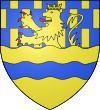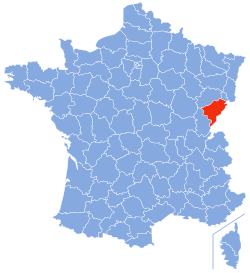- Doubs
-
This article is about the French department. For the town in this department, see Doubs, Doubs. For other uses, see Doubs (disambiguation).
Doubs — Department — 
Coat of armsLocation of Doubs in France Coordinates: 47°10′N 06°25′E / 47.167°N 6.417°ECoordinates: 47°10′N 06°25′E / 47.167°N 6.417°E Country France Region Franche-Comté Prefecture Besançon Subprefectures Montbéliard
PontarlierGovernment – President of the General Council Claude Jeannerot (PS) Area1 – Total 5,234 km2 (2,020.9 sq mi) Population (1999) – Total 499,062 – Rank 51st – Density 95.4/km2 (247/sq mi) Time zone CET (UTC+1) – Summer (DST) CEST (UTC+2) Department number 25 Arrondissements 3 Cantons 35 Communes 594 ^1 French Land Register data, which exclude estuaries, and lakes, ponds, and glaciers larger than 1 km2 Doubs (Arpitan: Dubs) is a department the Franche-Comté region of eastern France named after the Doubs River. Its pronunciation is [du] (the last two letters are silent).
Contents
History
Main article: County of BurgundyAs early as the 13th century, inhabitants of the northern two-thirds of Doubs spoke the Franc-Comtois language, a dialect of Langue d'Oïl. Residents of the southern third of Doubs spoke a dialect of the Arpitan language. Both languages co-existed with French, the official language of law and commerce, and continued to be spoken frequently in rural areas into the 20th century. They are both still spoken today but not on a daily basis.
Doubs was important as a portal to Switzerland through the pass at Joux. Many famous people, including Mirabeau, Toussaint Louverture and Heinrich von Kleist, were imprisoned in the Château de Joux.
Doubs is one of the original 83 departments created during the French Revolution on 4 March 1790. It was created from part of the former province of Franche-Comté. The prefecture (capital) is Besançon.
In 1793, the republic of Mandeure was annexed by France and incorporated into the department. This district was passed between various territories and departments in the ensuing administrative reorganisations and wars, but was restored to Doubs in 1816 when the former principality of Montbéliard was also added to the department.
However, the commune of Cerneux-Péquignot was annexed by the Canton of Neuchâtel under the terms of the 1814 Treaty of Paris, and since remained Swiss territory.
Between the defeat of France at the Battle of Waterloo and November 1818, Doubs was included in the area occupied by Austrian troops.
Victor Hugo, Gustave Courbet, and Auguste and Louis Lumière are among the famous people born in Doubs.
Geography
Doubs is part of the current region of Franche-Comté and is surrounded by the French departments of Jura, Haute-Saône, and Territoire de Belfort, and the Swiss cantons of Vaud, Neuchâtel, and Jura.
The department is dominated by the Jura mountains, which rise east of Besançon.
Politics
The President of the General Council is Claude Jeannerot of the Socialist Party.
Party seats • Socialist Party 16 Union for a Popular Movement 13 • Miscellaneous Left 3 Miscellaneous Right 2 MoDem 1 • The Greens 1 Demographics
The inhabitants of the department are called Doubistes.
Economy
The Doubs department is at the same time the greenest and the most industrialized in France.
It is the birth place of the automotive manufacturer Peugeot.
Tourism
The castle of Joux and Besançon are important tourist destinations.
See also
- Arrondissements of the Doubs department
- Cantons of the Doubs department
- Communes of the Doubs department
External links
- (French) Prefecture website
- (French) General council website
Categories:
Wikimedia Foundation. 2010.

